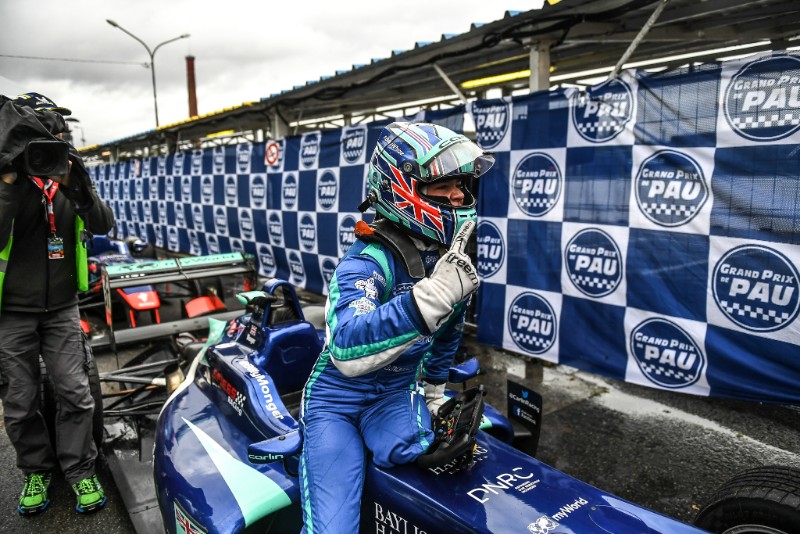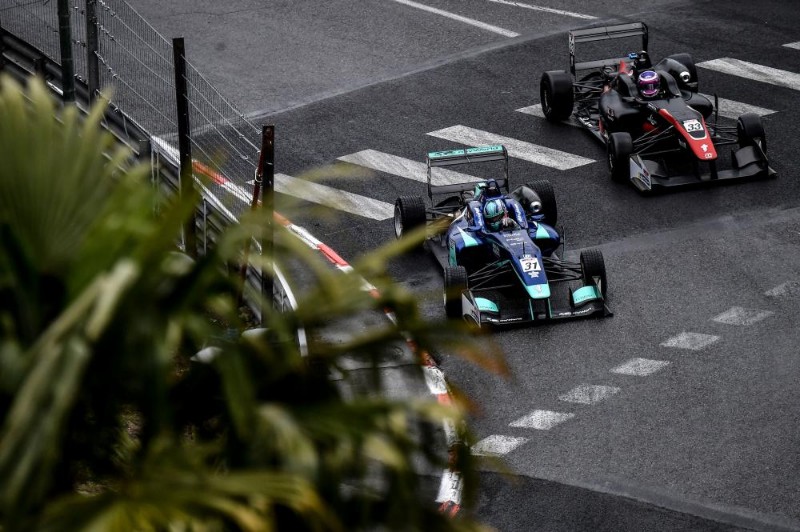
All photos: Fotospeedy
It’s very rare for motorsport to make mainstream news for anything other than tragedy, but since his own life-changing accident Billy Monger has been an exception to that rule.
His stunning Pau Grand Prix victory last weekend was displayed on the front of newspapers and television across Europe, as well as specialist media worldwide, and once again boosted his profile and that of junior single-seater racing.
Remarkably it was Monger’s first ever win in single-seaters, following on from five podiums in British Formula 4 and four top three finishes on his racing return in BRDC British Formula 3 last year.
After his Donington Park crash in British F4 in 2017, which resulted in both of his legs being amputated below the knee, Monger has raced with especially adapted equipment built by his Carlin team. This includes a hand clutch and a braking system which utilises one of his stumps rather than a prosthetic.
This very specific setup presents numerous challenges in a Euroformula Open car, and Monger has had to put on a lot of muscle mass to ensure he can apply the same peak numbers on brake pressure as his opposition. It’s an area he’s had to work on during the beginning of the season, including into the Pau weekend.
“We’ve been trying lots of different things to help solve that,” Monger explains.
“Pressure has been a big thing in this car. We’re now using different brake pads which seem to be helping us more. They’re stopping for the same pressure, they’re stopping the car more effectively. It makes the bleed off tricky, and it’s only something we’ve started using recently because it’s not really the ideal situation.

“Ideally we’d have the brake feeling the same as everyone else in the team does. And that’s something I’ve only had time to adapt to this weekend in Pau. Qualifying 1 was our first run using the new brake pads and seeing how the brake feels.”
That qualifying session was also Monger’s first experience of Pau in the dry, and after admittedly failing to put a good lap together he started his first street race from 10th.
While drivers sat on the grid, race organisers made the decision to reclassify the race as wet, prompting Monger and several others to switch to Michelin’s wet compound. Within two corners he had moved up to sixth, but the track had already dried up and the resultant pit stop back to slicks put Monger a lap down.
As he explained to Formula Scout post-race, the switch to wets was made under the presumption everyone else was, rather than a canny strategy call. In the second race though, the grand prix itself, a moment of inspiration propelled Monger to victory.
Once again Monger had failed to maximise qualifying, going 11th fastest out of 16. He was understandably disappointed.
“I lost four-and-a-half tenths in the last corner, and that would’ve put me P5,” he said. “But in the end, I think that was actually a blessing in disguise, because I think if I was starting fifth, I don’t know whether I would’ve taken that risk.”
That risk was the decision to pick the wet tyres, a switch he made at the end of the formation lap and which immediately dropped him to the back.

“Yesterday the call wasn’t ours, because my engineer genuinely made a mistake and thought everyone had to be on wets,” Monger confirms.
“But today, we were sat on the grid, and the rain started to come down a little bit, and then it got harder and harder, and I said to my engineer before we’d even started the green flag lap: I think this is going to be wets here.”
Within a few laps Monger was already in the top six, helped by a few others following his strategic blinder, but with the dominant Motopark quartet way up the road and matching his pace on their slick tyres, victory was not on Monger’s mind.
“I was just taking my time trying to pass each driver, but getting to them as quick as possible. I knew if it dried up I was always going to lose time.
“I lost track at one point of how many laps I had left, and came through and thought it said three when it was actually 13. But I didn’t realise until the next lap, so I knew I was in fourth and this guy [in front] was in third.
“If I wanted a podium at least I had to go for a move then. I went for the move, it was OK, I got the move done. And then just kept my eyes focused on going forward.
“There was a lot of tight moves out there. At the start of the race it was really tricky to judge because when it was so wet. I was on wets and they were on slicks, so the braking points that everyone was doing were sometimes catching me out.”

On lap 14 of 24, Monger came up behind Motopark’s Yuki Tsunoda, and made one of the overtakes of the race by slotting down the inside of the Red Bull junior through the narrow downhill Turn 13/14 chicane.
“That move was an accidental one,” Monger reveals. “I came round there, he was on slicks and braked really early, I wasn’t expecting it so I literally had to dive down the inside last minute.
Having taken the life out of the wet tyres very quickly in the first race, Monger avoided the same problem in the grand prix thanks to the wetter track surface; despite not having a proper warm-up procedure in either encounter.
With it being a half-hour race, he had to push on the tyres immediately, and as Monger describes it: “It was the Pau Grand Prix, I was always going to go flat out from lap one. And I carried on doing that until the point where I made contact with the wall at Turn 3.”
Picked up by the timing screens but not the TV cameras, Monger had scraped the right-hand side of his car against the barriers all the way around the Pont Oscar left-hander the lap after passing Tsunoda. It bent his steering, and the 20-year-old admitted he thought his race was over at that point.
The damage wasn’t terminal, but required an additional level of caution for the rest of the race. A challenge easier said than done when the lead Motopark duo of Julian Hanses and Liam Lawson collided and Monger was left leading the race, but with a long train of cars behind him as a result of a safety car intervention.
Those behind had no answer to Monger though, although several had the intelligence to use the safety car to pit for the correct rubber, and the Briton stretched an advantage to take a memorable, unlikely and historic win.
“I was screaming in my helmet like you wouldn’t believe [at the finish]. I just couldn’t believe it.
“To come to a street circuit and to have up until that point made the wrong calls and end up ninth, my engineer said to me yesterday that he was going to make up for those points, and hopefully more. Between me and him today, we certainly did that.”
